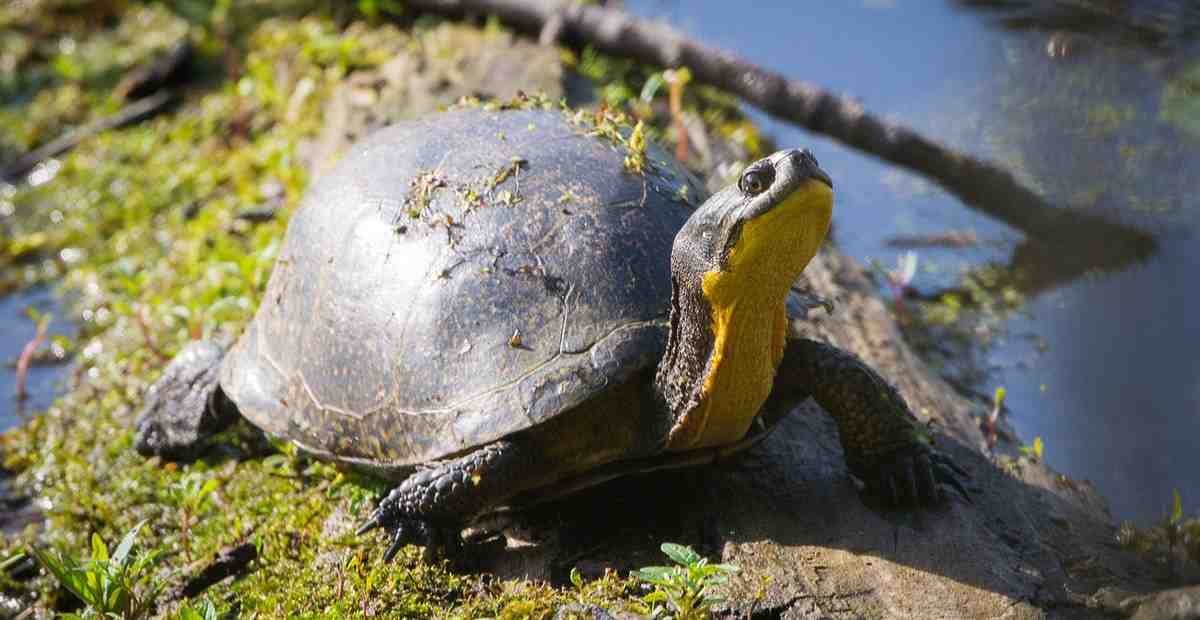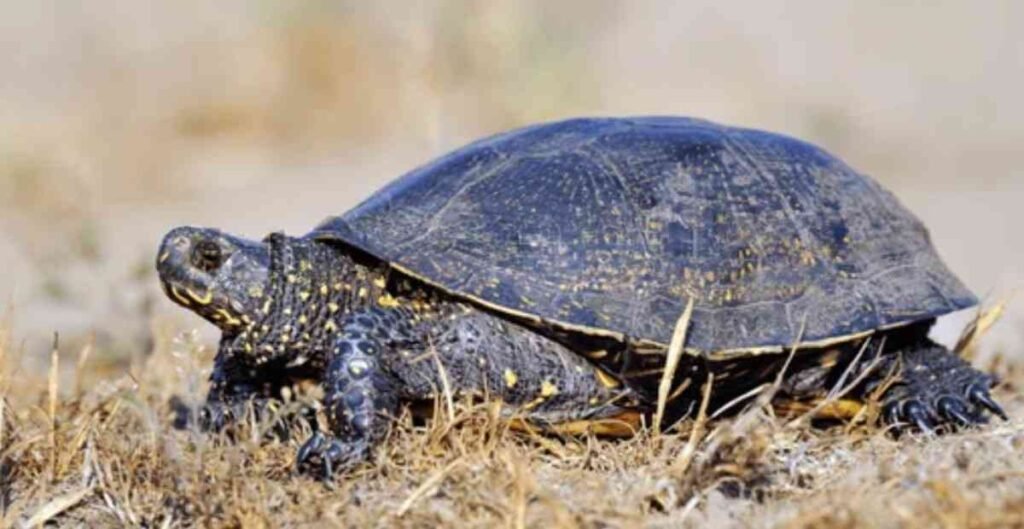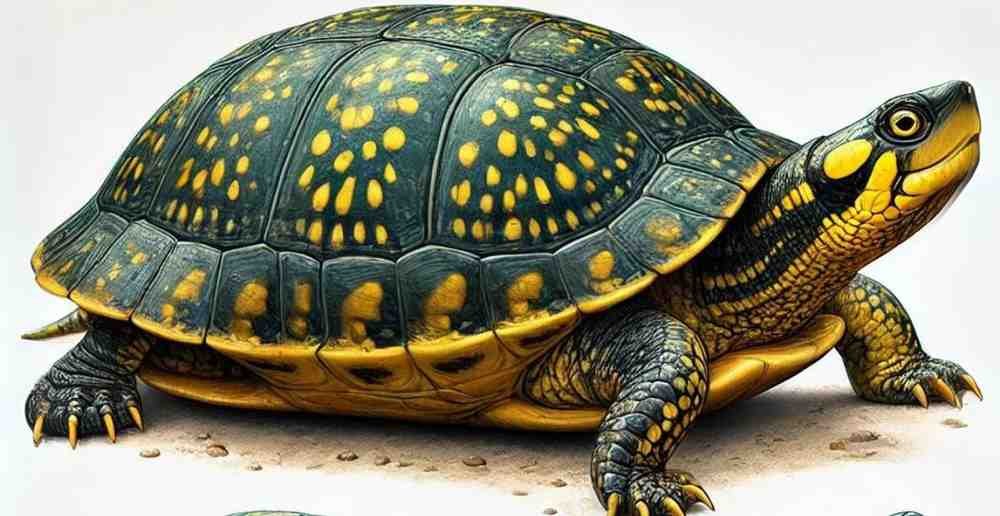The Blanding turtle is a species of freshwater turtle or semi-aquatic turtle. Scientifically, they are known as Emydoidea blandingii. Sadly, Blanding’s turtle is listed as another threatened turtle species in North America. The characteristics of Blanding’s turtle head in shell are like many other turtles, that retracts their head in shell.
Blanding turtle is recognized by their bright yellow throat, streamlined shell and distinctive speckled carapace. Blanding’s turtles pull their heads deep inside their shells for protection, which is a key survival trait in their attribute. Because of this, they can avoid predators in wetlands. So, today, our topic is to explore Blanding’s turtle head in shell, which means their retracting mechanism and head anatomy. If you are interested in this endangered turtle, keep reading.
Table of Contents
What Is the Anatomy of Blanding’s Turtle Head?

How Blanding’s turtle hides its head in the shell, before knowing it, we have to look into their head anatomy. Let’s see
Head and Neck Structure
Blanding’s turtles are known for their long and flexible necks that let them retract their heads deep into their shells. This turtle’s necks are structurally different from other turtles because they have a line of vertebrae and muscles that resemble an S shape.
In comparison with other species, their unique structure gives them more mobility and the ability to retract their heads. It enhances their protective abilities. Furthermore, Blanding’s turtle holds its head backward when retracted, unlike other turtles. They push the head close to the carapace and cover its most sensitive parts, which are its forelimbs and back end.
Role of the Skull and Jaw
Blanding’s turtles have strong, solid jaws that help them eat omnivorous foods. They can consume crayfish, insects, and small fish due to the strength of their beak. Their skull is equipped with bone plates around the head for extra protection. These plates help shield critical areas when the turtle retracts its head along with its hinged plastron. Due to their anatomical design, they can survive in a variety of wetland environments while hunting for food both on land and in water.
How Does Blanding’s Turtle Pull Its Head into Its Shell?
Blanding’s Turtles defend themselves against predators through head retraction. This mechanism involves muscles and ligaments so the turtle can quickly pull its head into its shell. Here’s a detailed explanation of how it works:
Retraction Process
Blanding’s Turtles have muscles around their necks and shoulders that retract their heads when they feel threatened. During contraction, these muscles pull the head back, and flexible ligaments help keep it in place. Using this rapid retraction, turtles protect their most vulnerable parts, making them hard to attack.
This ability of Blanding’s turtles is also useful when they’re trying to escape animals like raccoons and foxes. Once the turtle’s head is withdrawn, its smooth, rounded shell acts as a shield. This tough exterior helps Blanding’s turtles survive encounters with predators.
Head-in-Shell as a Defense Mechanism
Blanding’s Turtles have evolved this retractable head as a survival strategy as well as a quick defense. Over millions of years, they’ve used this ability to escape threats, especially in habitats where humans or predators are more prevalent.
For instance, Blanding’s Turtles often live in wetlands, but they travel across land between ponds and other habitats. In these moments, when they’re more vulnerable to predators or humans, their head-retraction ability gives them a fighting chance. Their long-term survival depends on this mechanism.
This defense mechanism has helped Blanding’s Turtles thrive in regions like the Great Lakes and Canada. Despite this, habitat loss and other threats have put their populations at risk.
Where Does Blanding’s Turtle Live and Their Behavior

Where do Blanding’s turtle species live as semi-aquatic turtles? Here’s their habitat details –
Preferred Habitats
Blanding’s Turtles live in slow-moving rivers, marshes, and ponds. However, as semi-aquatic, they also live in the wild. They can shelter, eat, and bask in these habitats, which are filled with dense aquatic vegetation. In addition to breeding, feeding, and protection from predators, wetlands are the most suitable places for them to survive. In particular, wetlands with both open water and vegetation are ideal for Blanding’s turtles since they offer both safety and resources.
Blanding’s Turtles migrate between wetlands to find suitable nesting sites on land. Often, they travel over long distances on terrestrial surfaces. Their terrestrial movement makes them vulnerable to habitat fragmentation and human interference, like road crossings.
Diet and Feeding Behavior
Blanding’s Turtles are omnivores. So, they eat a variety of small aquatic organisms, including fish, insects, snails, and crustaceans, as well as plant-based food. Their strong, broad jaws are made to crush the shells of their prey, which helps them to consume tougher food.
The turtle’s ability to pull its head back into the shell also helps it ambush prey. While hiding in vegetation, they can easily grab small fish and insects by quickly extending their necks.
Blanding’s turtle’s omnivorous diet not only promotes their growth but also protects their wetlands habitat balance. Because it helps control insect populations and contributes to balancing aquatic ecosystems.
How Long Do Blanding’s Turtles Live?
In the wild, Blanding’s Turtles can live over 70 years, and some of them even reach 80. Considering the challenges turtles face in their environment, this longevity is quite impressive. However, turtles are known to have longer lifespans. While Blanding’s turtle lifespan is long, their reproductive process is slow, which makes them vulnerable to a decline in their population.
How Does Blanding’s Turtle Reproduce?
As an endangered turtle species, how do Blanding’s turtles continue their reproduction? Let’s look at them –
Reaching Sexual Maturity
Blanding’s Turtles reach sexual maturity around 14 to 20 years old. Their mating season usually occurs in spring, in shallow water. The females then migrate to suitable nesting areas, usually 1.5 miles away, to lay their eggs in sand or loam.
Nesting and Incubation
A female usually lays 6 to 21 eggs in late May or June. These eggs incubate for about 75 to 105 days, depending on temperature. Their hatchlings emerge in late summer or early fall. However, survival rates for young turtles are quite low due to predation by animals like raccoons and skunks.
Hatchling Challenges
Like many other turtle species, Blandig’s turtle hatchlings face significant challenges. It includes predation, environmental hazards, and difficulty in finding food. Only a small percentage of hatchlings survive to adulthood. The reduced survival rate makes it even more important to conserve adult turtles.
Size
The Blanding’s turtle size typically ranges from 5 to 8 inches (13 to 20 cm) in shell length. Some adults can reach up to 10 inches (25 cm), depending on the region and habitat.
Comparison to Other Turtle Species WIth Blanding Turtle

Often, Blanding’s Turtles are compared with Painted Turtles (Chrysemys picta) and Common Snapping Turtles (Chelydra serpentina) whose heads retract into their shells. The main difference between Blanding’s Turtles and other turtles is how their heads retract. In contrast to most turtles, Blanding’s Turtles bend their necks in an S-shape vertically. Because of this, they can pull their heads way deeper into their shells than other species, so they’re more protected.
In contrast, Snapping Turtles use their strong jaws and aggressive behavior to defend themselves. While the Painted Turtle has a traditional retraction mechanism, Their skills in the water with speed and agility keep them ahead.
The Blanding’s Turtle’s elongated neck and flexible muscles help them to retract its head deeper. As a result, it’s a bit different from most other species when it comes to defense.
Why Blanding’s Turtles Are Endangered?
The Blanding’s Turtle (Emydoidea blandingii) is currently listed as an endangered species by the IUCN. In regions like the Great Lakes and Midwest, populations have declined across North America. The main reason for this decline is habitat destruction, as wetlands are drained and developed for agriculture and urbanization.
Other threats include turtle poaching, in which turtles are captured and imported as pets. There are also risks like raccoons or other predation, which eat turtle eggs and hatchlings.
Initiatives for conservation
It’s all about habitat restoration, reducing road deaths, and breeding programs for Blanding’s Turtles. In Michigan and Ontario, organizations are restoring wetlands, creating wildlife corridors, and installing turtle crossings to protect migrating turtles. The goal is to reintroduce captive-bred turtles into the wild through breeding programs. Also, avoiding turtle capture for pets and supporting conservation programs can help save this species for future generations.
Bottom Line
The ability to hide Blanding’s turtle head in shell is a common turtle trait. However, their technique and neck structure are a bit different from those of other turtle species. Blanding’s turtle endangered status is a concern for the earth’s ecological balance. As it is an endangered species, we should be more responsible for saving them. In order to ensure future generations have access to the Blanding’s Turtle, we must raise awareness and protect their environment.
